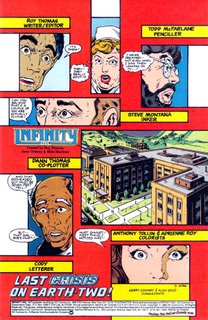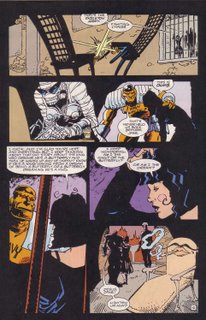Infinity Inc. #1-16
As I mentioned a while back, I decided I should probably take a pass at re-reading Infinity Inc since many of the characters are getting worked back into continuity. As a kid, I was always very curious about the series, but could never afford it. If I recall correctly, it was the first of DC's titles to be published in the premium format (or at least the first one that wasn't doing the year-delayed reprints that Legion and Teen Titans did), so given the choice between buying three regular comics or one issue of Infinity Inc, quantity always won out. Towards the end of one summer, however, I found a comic shop that was dumping its back issues for bargain prices, so picked up what was just about a complete run on the title.
I was certainly a sucker for anything Earth-Two as a kid. Some of my earliest superhero comic memories are of the "Countdown to Crisis" JLA/JSA crossover, and I started reading All Star Squadron as soon as it was available. So, you can imagine my excitement when I got my hands on the run of Infinity Inc.
However, I remember the acquisition much better than I remember actually reading the comics. Which, rereading them as an adult, makes perfect sense. The issues themselves are eminently forgettable. Particularly brutal is the initial 10 part story arc that kicks off the series. And it's a stupid story arc. The JSA members drink from the waters of the Stream of Ruthlessness and turn evil. There's some really pointless time travelling thrown in there as well, but, really, it's an unbelievably pointless story arc. I supposes it introduces the characters, but most of the characterization is pretty flat - Todd's got a chip on his shoulder, Hector is a preppy asshole, Jenny likes to talk to herself in thought bubbles at great length. It's rough going. Last time I tried reading it, it was enough to get me to stop reading comics for a week. Fortunately, once the brutal opening arc gets out of the way, things start to pick up. Surprisingly, what really gives the series a kick is Todd McFarlane.
Now, don't get me wrong. I hate Todd McFarlane. I hate his art. I hate his litigiousness. I hate his overwhelming ego. But, his art here? It's not bad. There's certainly some Chaykin/American Flagg influence, but also a pretty odd idea of how to construct panels. Part of this may be due to some very sparse scripting, but it's kind of interesting. Especially for 1985.

I'm not saying it's groundbreaking, but it certainly gives the series more energy than it had before. Which is probably good, given the general turgidness of the plots and characters. Of course, no amount of interesting panel layout is going to compensate for the McFarlane costume design (Chroma, Mr. Bones, pretty much everyone in Helix).
Really, the stumbling block on the series is Thomas' writing. I'm really torn on the guy. He certainly gets a whole lot of points in my book for keeping up interest in the Golden Age roster throughout the 80's. Without him, I'm not sure we'd have the interest in the characters to support the current JSA series. Or at least not the editorial willingness to publish it. On the other hand, his writing is unforgivably dated. Really, none of the characters feel remotely real, except for Nuklon (though, I'm not sure why Thomas wanted to cast Al in the role of fish out of water - wouldn't the guy from the hidden island of birdmen be a better candidate for that than the nice Jewish boy from Florida?). The characters spend an inordinate amount of time arguing, which tends to slow what little plot there is to a crawl. I may continue for a few more issues, just to see where it goes (It ran for over 50 issues? Really?), but I've got better things to read.
ETA: OK, so a few issues after the bit I included above, McFarlane apparently decided to start doing Miller. Or maybe Giffen doing Miller. Honestly, I think I prefer his attempts to be someone else than his "personal" style.

I was certainly a sucker for anything Earth-Two as a kid. Some of my earliest superhero comic memories are of the "Countdown to Crisis" JLA/JSA crossover, and I started reading All Star Squadron as soon as it was available. So, you can imagine my excitement when I got my hands on the run of Infinity Inc.
However, I remember the acquisition much better than I remember actually reading the comics. Which, rereading them as an adult, makes perfect sense. The issues themselves are eminently forgettable. Particularly brutal is the initial 10 part story arc that kicks off the series. And it's a stupid story arc. The JSA members drink from the waters of the Stream of Ruthlessness and turn evil. There's some really pointless time travelling thrown in there as well, but, really, it's an unbelievably pointless story arc. I supposes it introduces the characters, but most of the characterization is pretty flat - Todd's got a chip on his shoulder, Hector is a preppy asshole, Jenny likes to talk to herself in thought bubbles at great length. It's rough going. Last time I tried reading it, it was enough to get me to stop reading comics for a week. Fortunately, once the brutal opening arc gets out of the way, things start to pick up. Surprisingly, what really gives the series a kick is Todd McFarlane.
Now, don't get me wrong. I hate Todd McFarlane. I hate his art. I hate his litigiousness. I hate his overwhelming ego. But, his art here? It's not bad. There's certainly some Chaykin/American Flagg influence, but also a pretty odd idea of how to construct panels. Part of this may be due to some very sparse scripting, but it's kind of interesting. Especially for 1985.

I'm not saying it's groundbreaking, but it certainly gives the series more energy than it had before. Which is probably good, given the general turgidness of the plots and characters. Of course, no amount of interesting panel layout is going to compensate for the McFarlane costume design (Chroma, Mr. Bones, pretty much everyone in Helix).
Really, the stumbling block on the series is Thomas' writing. I'm really torn on the guy. He certainly gets a whole lot of points in my book for keeping up interest in the Golden Age roster throughout the 80's. Without him, I'm not sure we'd have the interest in the characters to support the current JSA series. Or at least not the editorial willingness to publish it. On the other hand, his writing is unforgivably dated. Really, none of the characters feel remotely real, except for Nuklon (though, I'm not sure why Thomas wanted to cast Al in the role of fish out of water - wouldn't the guy from the hidden island of birdmen be a better candidate for that than the nice Jewish boy from Florida?). The characters spend an inordinate amount of time arguing, which tends to slow what little plot there is to a crawl. I may continue for a few more issues, just to see where it goes (It ran for over 50 issues? Really?), but I've got better things to read.
ETA: OK, so a few issues after the bit I included above, McFarlane apparently decided to start doing Miller. Or maybe Giffen doing Miller. Honestly, I think I prefer his attempts to be someone else than his "personal" style.



